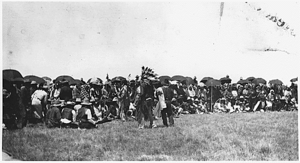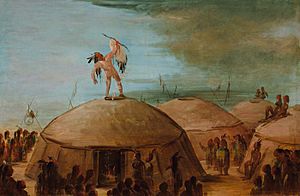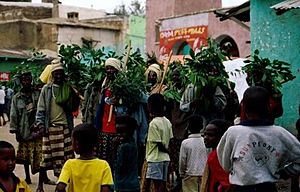Rainmaking (ritual) facts for kids

Rainmaking is a special ritual that people perform to try and make it rain. It's a type of weather modification, which means trying to change the weather.
One of the most famous examples of these rituals are rain dances. Many Native American tribes, especially in the Southwestern United States, have historically performed these dances. Some of these rainmaking rituals are still practiced today.
Contents
Examples of Rainmaking
Rainmaking in North America

Julia M. Buttree wrote about the rain dance of the Zuni tribe. She described how they wear feathers and blue items like turquoise during the ceremony. Feathers stand for wind, and blue items represent rain. The Zuni people have passed down the details of how to do the Rain Dance through stories from older generations.
Long ago, some Native American tribes in the central United States were very good at observing weather patterns. They would sometimes offer to perform a rain dance for settlers. In return, the settlers would give them items for trade. This was common among the Osage and Quapaw tribes in Missouri and Arkansas.
In April 2011, the governor of Texas, Rick Perry, asked people to pray for rain. This was during a time when Texas was experiencing a very bad drought.
Rainmaking in Africa
Rain is very important for many African societies. They rely on it for their food and for their animals to survive. The power to make rain is often believed to belong to African kings. In some societies, if a king could not bring rain, people might blame him.
A famous rainmaking leader is the Rain Queen of Balobedu in South Africa. Tribal rain dances are performed to help ensure that rain will come. People from tribes in the Sahara Desert and Ethiopia are known for doing rain dances.
Rainmaking in North Africa

Rainmaking in China
In ancient China, Wu Shamans performed special dance ceremonies to make rain. They did this during times of drought. Wu shamans were thought to be able to talk to nature spirits that controlled rain and floods. It was said that shamans would dance inside a ring of fire until they sweated a lot. The drops of sweat were believed to help bring the desired rain.
Rainmaking in Europe
Ancient Roman religion had a ceremony called the aquaelicium. This Latin word means "calling the waters." It was used to try and make rain during dry periods. During this ceremony, priests would bring a special stone, called the lapis manalis, to the Senate. They would make offerings to Jupiter, asking him for rain. Water was also poured over the stone as part of the ritual.
In Slavic and Romanian cultures, there are rainmaking rituals known by names like Caloian and Dodola and Perperuna. Some of these traditions continued into the 20th century.
See also
 In Spanish: Danza de la lluvia para niños
In Spanish: Danza de la lluvia para niños


